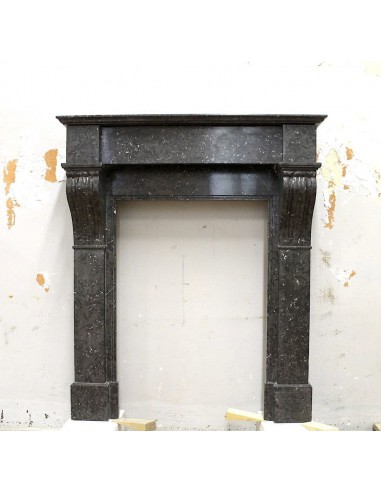LILLIPUTIAN "MODILLON" FIREPLACE IN GREY SAINT'ANNE MARBLE, PERFECT CONDITION, FROM FRANCE, SECOND HALF OF THE 19TH CENTURY.
How many things there are to tell about this tiny and apparently unimportant, fireplace.
I could “work” (I quote this verb because for me this commentary is not work, but pleasure) devoting my time to commenting on a perhaps more expensive fireplace, from which I would derive greater economic benefit, but I will devote a few hours of this afternoon to our very small Modillon. By the way, this particular specimen is particularly sympathetic to me, perhaps because it is the smallest chimney in our warehouse and little ones (it's a law that applies to all people) arouse in us tenderness, sympathy and a sense of protection, don't they!
LET'S SEE TOGETHER, IF YOU WANT, ITS MANY (and even “miraculous” (you will understand later why I say this) FEATURES':
A) First of all, it must be said that he (the mantel) was carved specifically for a child's room (it was certainly a boy, since the stylism chosen is part of the neoclassical family, which are the “male” styles par excellence. How, did you not know that fireplaces, just like humans, are divided into male and female! Well, another paragraph would open here that would be too long to go through.... Let's do this, when you come to see me I will explain, having the chimneys themselves in front of you, what their sex difference consists of.. Don't worry, you will understand right away, and easily, it will be easier than you can imagine...) and that is why it was made in “Barbie-like”, or rather “Ken-like” measurements, basically miniaturized so that the little one, from the very first steps could be familiar with beautiful, decorative, stylish things. The concept was this: My son must be born into beauty, refined culturally from his earliest days, in short, underneath, be what his father, perhaps, was not but would have liked to be.
B) It is the more properly “hausmannienne” model of a fireplace, an adjective derived from the name of the famous prefect who, in the Napoleon III era, gutted and remade the center of Paris. Hausmann, it is said, chose it for its being simple and dignified. I have an idea of my own as to why this choice was made : Hausmann was a prefect (later made an honorary architect) and in that capacity, administered the reconstruction of a large portion of the city of Paris that he himself had demolished to make way (for military/social/political/monumental purposes etc.) for the Champs-Elysées . Well, for the thousands of fireplaces that he had to rebuild he chose mainly two models of fireplace mantels, a Louis XIV so-called “Boudin” and our Louis Philippe “Modillon,” as it happens, both models that could be made in his homeland and both models with low costs. In this way he saved the Napoleon III coffers a great deal of francs. All this parrot to be able to go so far as to say. If we had administrators of similar probity in Italy, we would be the richest people in the world!!!
C) It is a fireplace, this one, much taken up by the architects of the Deco' period because of its geometric lines and minimalism, which is why, although it is not really of the 1920s or 1930s era, it will be able to figure well in Art Deco period dwellings.
D) Its marble is called “Gris Saint'Anne ” and is quarried in the French Pyrenean slope, at Pau, very close to the grotto of Lourdes. It is likely that its “holy” name has to do with the most important and miraculous grotto in the world, however, I cannot disquisition here because my religious knowledge is close to Zero. This marble, with its “gunmetal gray” color, is studded with very small and evenly distributed marine fossils. With a little imagination, its surface looks like that of a night sky inhabited by a thousand and one tiny white stars. A “Gray,” in short, “Salt and Pepper,” certainly fascinating.
E) And now we come to its name, which has Italian origins.... In order to better understand how a French fireplace can have an Italian name, I make you aware of a “secret”: In the 19th century the French had no real school of sculpture, a little was made in the French Riviera (Nice or Marseilles especially) because of the presence of ports, a little in the north (but much less) because of a few ports in the Channel, little and nothing inland. This phenomenon also depended on the fact that the French, of decent marbles, had very few and, consequently, the number of sculpture workshops was also at a minimum. In Italy, on the other hand, the school of sculpture was THOUSANDS OF YEARS old; we even know its year of birth, 399 B.C.. In that year, in fact, the Romans conquered Veio, the capital of Etruria, and suddenly found themselves masters of the Apuan Alps. "Quite a SEAT! ” one might say because the Apuan Alps contained (and in quantities that then appeared endless, inexhaustible..) the most beautiful marbles in the world.. And Rome, in those days had a few tens of thousands of citizens, living, for the most part, in hut-like houses.. IMPERIAL ROME STILL HAD TO BE BORN AND IT WAS THE SCALPELLINI OF THE LUNIGIANA (which was, indeed, the land on the slopes of the Apuan Alps) WHO BUILT IT. In short, the Italian school was, in the nineteenth century, when our fireplace was born, at least 2,200 years old while the French school was practically nonexistent.. But the French, in certain trades are smart (more so than us Italians.. Don't believe me? Do you want proof? We produce EXACTLY the same amount of wine as the French, only they gross EXACTLY three times as much as we do.. Do you think we're assholes?!) and so they commissioned Italian sculptors from Lunigiana (Sarzana, Carrara, Pietrasanta to name the most important “marble” towns in that region...) to make their fireplaces. In essence, we were, for at least two centuries, THEIR CHINESE!!!). Now that you know this, you will also understand how it was inevitable that many names belonging to the French “Marmerie” came from the language of the Italian sculptors who materially made their designs. If you ask in France (which I have done perhaps a thousand times) what the name “Modillon” means, no one can tell you. In fact, this “nik” is derived from the archaic Italian “Modiglione,” which stands for “capital, corbel, projecting overhang”-essentially the most obvious architectural motif of our friendly Louis Philippe fireplace mantel.
I HAVE EXHAUSTED YOU, HAVEN'T I? FORGIVE ME, I DID IT FOR GOOD, I WAS SO LONG-WINDED TO SATISFY THOSE WHO, OF THIS FIREPLACE, WILL REMAIN IN LOVE AS I WAS AT THE TIME OF ITS PURCHASE.






























































